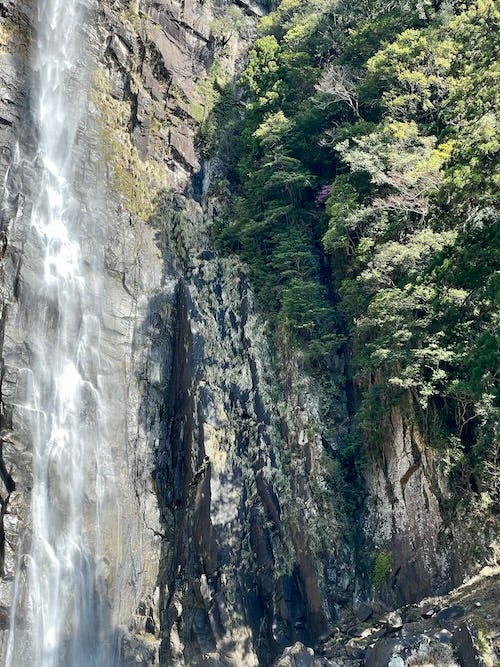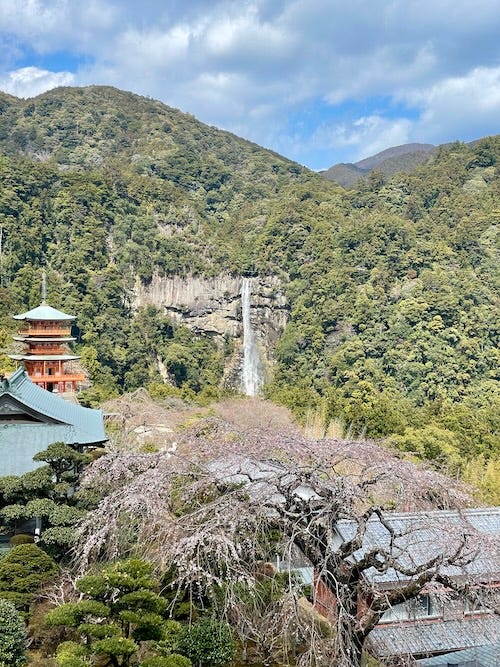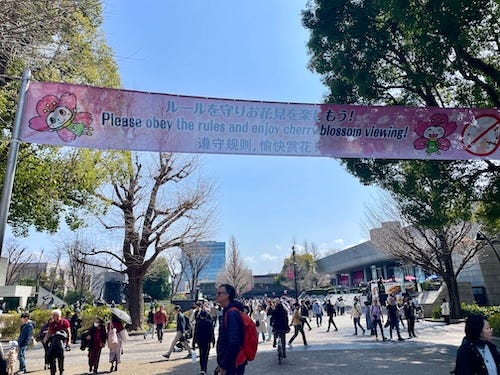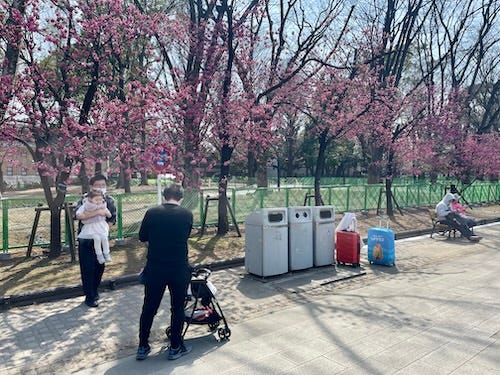As many of you know Christopher and I spent the last two and a half weeks of March in Japan. I will be sharing memories and fermented food stories from the trip in future posts. This trip was the realization of the many times delayed rescheduling of a trip that had been planned for March 2020. This time the March time frame was based on the practicality of schedules, nothing more. However, being spring and all, we knew there was some chance we would witness Sakura, if it came a bit early. Sakura is the Japanese word for cherry blossom, and typically refers to the ethereal pink show of the ornamental cherry trees, cultivars of Prunus serrulate. This national flower of Japan represents not only the renewal and optimism that marks longer days and the end of winter but their fleeting appearance embodies the transient nature of life.
Before we left home, we thought we might’ve accidentally timed it perfectly. In February the Sakura forecast showed an early bloom due to an unseasonably warm spring. However, the weather was cool, even cold, while we were there—in other words a normal spring—which is, it seems, increasingly not normal across the planet. The forecast dates crept forward, and we did not see a full row of cascading delicate pink bowers of the Yaezakura (double blossom) in Ueno Park in Tokyo. We left just as it was beginning there. As I write this it is the middle of peak season in Tokyo and nearing the end to the south. Do I feel like I missed this magical cultural experience and beauty? Not at all.
The excitement of the season had begun, and Sakura’s anticipation and seasonal specialties were in full swing. Other varieties of cherries were blooming here and there and every tree we passed in Tokyo that first week was the backdrop for a photo shoot. Stationery stores sold pink-blossom festooned cards and stickers. On every menu, there was a pink homage to the cherry blossom, some even included genuine blossoms. I had a delicious lemonade dusted with bits of pink blossoms. I can’t say whether they were dried, frozen, or fresh—maybe? I can say they weren’t Sakura No Shiozuke, a traditional salt-cured blossom used to sweetly salt and decorate sweets or other meal presentations.
The next part of our trip was to visit the remote and beautiful area of the Kumano Kodō which, not unlike the Camino de Santiago, is series of ancient pilgrimage tails that zigzag through mountains in the Kii Peninsula linking the Three Grand Shrines of Kumano: Kumano Hongū Taisha, Kumano Nachi Taisha and Kumano Hayatama Taisha. It is a remote and beautiful area. We walked small stretches of Kumano Kodō, took many delicious baths in mineral rich onsen waters, saw the Three Grand Shrines, and where delighted by blooming cherry trees around every corner.
My phone has an embarrassing number of drive by pictures of random sakura blossoms erupting alongside the road because I want to share the enchantment of these wilder sakura blossoms and I apologize in advance for this wee snapshot dump. (I was equally delighted by the shrines and mesmerized by the trees and ancient root strewn paths of the trails—I am sparing you the million or so more photos I took in the forests.)




The last part of our trip was to visit three fermentation factories in Kagoshima and spend time with our dear friend (and miso maker) Midori and her family in Kumamoto. Wild windy weather stranded us on Wakushima Island (there are worse places to get stuck) but robbed us of this part of our adventure. We finally made it to Kumamoto nearly two days later, after dark.
Her lovely family made sure we didn’t miss Hanami in Kumamoto where the sakura were on. Hanami is the custom of viewing and spending time with these blossoms. Think about that for just a moment, stopping, sighing out stress, and spending time with blossoms. Our late night picnic was just what we needed after hours of negotiating transportation—cars, hydrofoil ferry, and trains (with too much food heavy luggage)—to get to that moment.
This was one of our last evenings in Japan. When we came home our own cherry trees where beginning to bloom but haven’t been able to out do the fuchsia blossoms that spill out in a messy wild rant from an ancient unpruned crab apple in the old garden of the previous farmstead. Its untamed garishness is one of my favorite spring moments here. I was happy we didn’t miss it.
Holding on to the moment
We humans do like to try to cup moments of pleasure in palm of our hands—holding tight. While the show of sakura, or the blossoming trees near you, is perfectly impermanent. You can have a little fun with blossoms and fermentation.
This post on how blossoms make Drunk Bees is a fun and appropriate read (or reread) for this time of year. I also love playing with wild yeast foraging this time of year. In this little class I recorded in 2020 I take you on a walk through our woods and teach you how to connect with the blossoms and the hidden flavors of place through wild yeast harvesting.
What is the noticeable color where you are? Take a moment to breathe it in.
Enjoy your weekend.







Your messages every week make me forget the world while I read them. Of course your information is solid and I've been following you all about 8 years now and love love love your books. Bless you for your drive to learn, share, inform and educate about fermenting. It has drastically improved my life and that of my family. We've re-bonded over ferments. I'm seriously considering becoming a substack member, because the respite you provide. AND your insights share beauty, reignite dreams and hope. Your line about spending time with the blossoms... I'm inspired to go to our local garden park and just breathe. Thank you for your posts.
I just read your post about the food of place. It’s very sad how waterways are drying up. In Australia we have learnt a lot from Peter Andrews and the concept of leaky weirs. Beavers would build them a lot better than a human could!